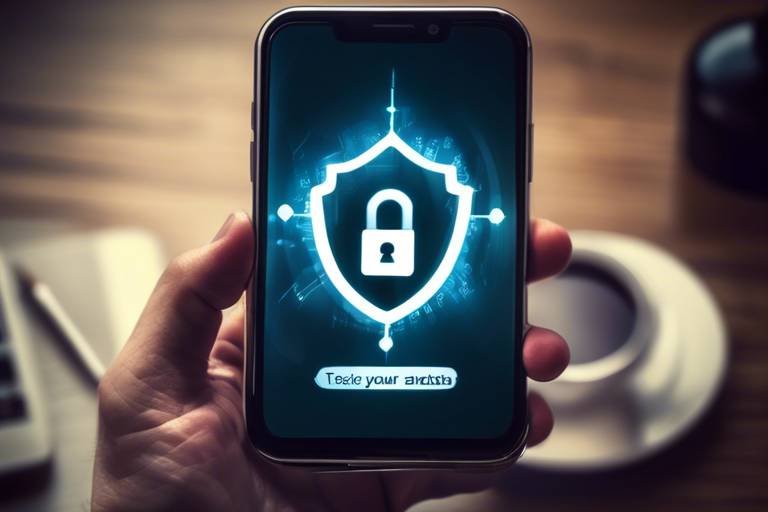How to Keep Kids Safe Online
In today’s digital age, keeping our kids safe online is more important than ever. With the internet being an integral part of their lives, they are exposed to a world filled with information, entertainment, and, unfortunately, potential dangers. As parents, it’s our responsibility to equip our children with the tools and knowledge they need to navigate this vast online landscape safely. But where do we start? How can we ensure that our kids are not only protected but also empowered to make wise decisions while surfing the web? In this article, we’ll explore essential strategies and tools that can help ensure children’s safety in the digital world, from parental controls to fostering open communication about their online behavior.
Before diving into protective measures, it’s crucial to understand the various risks children face online. The internet can be like a double-edged sword; while it offers incredible resources and opportunities, it also harbors threats such as cyberbullying, exposure to inappropriate content, and the lurking presence of online predators. Cyberbullying, in particular, can be devastating, as it often occurs in spaces where children feel safe and comfortable. Moreover, inappropriate content can pop up unexpectedly, leaving kids vulnerable to things they aren't ready to process. Lastly, online predators can disguise themselves as friends, making it essential for parents to be aware and proactive. By recognizing these dangers, parents can develop effective strategies for protection and foster a safer online experience for their children.
One of the most effective ways to keep kids safe online is to establish an open line of communication. Encouraging your children to share their online experiences not only fosters trust but also helps you identify potential risks early on. Imagine your child as a ship sailing through the vast ocean of the internet; without a lighthouse to guide them, they might drift into dangerous waters. By discussing their online activities, you can act as that guiding light, ensuring they feel comfortable discussing any concerns they may have. Questions like, “What did you see online today?” or “Have you encountered anything that made you uncomfortable?” can open the door for meaningful conversations.
Creating a secure online environment is essential. This involves several proactive steps, including:
- Utilizing privacy settings on social media platforms.
- Monitoring devices and online activities.
- Educating children about the importance of safeguarding personal information.
By taking these steps, you can help ensure that your child’s online experience is as safe as possible. For instance, adjusting privacy settings can limit who sees their posts and personal information, while regular discussions about what constitutes private information can empower them to make safer choices.
Parental control software can be a game-changer in managing your children’s online activities. These tools allow you to filter content, set time limits, and monitor usage effectively. Think of it as a safety net that catches your child before they fall into the depths of inappropriate content or excessive screen time. By implementing these controls, you can create a balanced approach to technology that promotes healthy online habits while still allowing for exploration and learning.
Teaching children the importance of responsible online behavior is crucial. This includes discussing:
- The concept of digital footprints and how their actions online can have lasting consequences.
- The impact of sharing personal information.
- Understanding the repercussions of their actions, both online and offline.
By instilling these values, you empower your children to be mindful of their online presence, helping them to navigate the digital world with confidence and responsibility.
As parents, it’s essential to be vigilant in observing behavioral changes in your children that may indicate online issues. Signs such as withdrawal from family activities, sudden changes in mood, or reluctance to use certain devices can be red flags. By being attentive and proactive, you can address any potential issues before they escalate, ensuring that your child feels supported and safe.
Understanding what cyberbullying is and how to recognize it empowers children to stand against it. Cyberbullying can take many forms, from hurtful messages to social exclusion, and it can have serious emotional consequences. By educating your child about the signs of cyberbullying, you can help them identify when they or their peers are being targeted and encourage them to seek help when needed.
Teaching kids coping strategies and resilience is vital in helping them deal with online negativity. Imagine resilience as a sturdy umbrella that protects them from the rain of online harassment. By equipping them with tools to respond to bullying and negativity, you make them less susceptible to the harmful effects of these experiences. Strategies such as positive self-talk, seeking support from friends or adults, and engaging in offline activities can help reinforce their self-esteem.
Lastly, it’s crucial to encourage children to report any online abuse or harassment. Make sure they know how to seek help from trusted adults or authorities when needed. This support system can be their lifeline, ensuring they never feel alone in facing online challenges. Remind them that it’s okay to ask for help and that they have the power to stand against online bullying.
Q: What are some signs that my child may be experiencing cyberbullying?
A: Look for changes in behavior, such as withdrawal from family activities, unexplained mood swings, or reluctance to use their devices.
Q: How can I start a conversation with my child about online safety?
A: Begin by asking open-ended questions about their online experiences, and create a safe space for them to share their thoughts and feelings.
Q: Are parental controls effective?
A: Yes, parental controls can help manage your child's online activities, but they should be used in conjunction with open communication and education about responsible online behavior.

Understanding Online Risks
In today's digital age, it’s essential to recognize that the internet, while a treasure trove of information and entertainment, also harbors a myriad of risks that can pose serious threats to children. From the moment they log on, children can encounter dangers that range from cyberbullying to exposure to inappropriate content. It’s crucial for parents to be aware of these risks to effectively protect their children.
One of the most alarming threats is cyberbullying. Unlike traditional bullying, which is often limited to physical spaces like schools, cyberbullying can happen anytime and anywhere. It can manifest through hurtful messages, spreading rumors, or even sharing embarrassing photos online. This form of bullying can have devastating effects on a child's mental health, leading to feelings of isolation, anxiety, and depression.
Moreover, children are often exposed to inappropriate content that can be harmful to their development. This includes violent videos, explicit images, and other adult-themed material that they are not emotionally equipped to handle. Even with the best intentions, children can stumble upon such content accidentally, which can lead to confusion or distress.
Another significant risk is the presence of online predators. These individuals use the internet to exploit children, often posing as peers to gain their trust. The anonymity of the internet can make it incredibly challenging for children to identify when they are interacting with someone who has harmful intentions. It’s a frightening reality that underscores the importance of parental vigilance and education.
To better understand these risks, let’s break them down into key categories:
| Risk Type | Description |
|---|---|
| Cyberbullying | Harassment or bullying that occurs online, often through social media or messaging platforms. |
| Inappropriate Content | Exposure to violent, sexual, or otherwise unsuitable material that can impact a child's mental health. |
| Online Predators | Adults who seek to exploit children online, often by pretending to be someone they are not. |
It’s not just about recognizing these risks; it’s about taking proactive steps to mitigate them. Parents should educate their children about the potential dangers they might face online and encourage them to be mindful of their digital interactions. Open discussions about online activities can help children feel comfortable sharing their experiences, which is vital for spotting potential threats early on.
In summary, understanding online risks is the first step toward creating a safe digital environment for children. By being informed and proactive, parents can help their kids navigate the complexities of the internet while minimizing exposure to its dangers. After all, the goal is not to shield children from the online world entirely but to empower them to engage with it safely and responsibly.

Establishing Open Communication
Establishing open lines of communication with your children is like building a sturdy bridge that connects their online world to your understanding. It’s essential for parents to foster an environment where kids feel comfortable sharing their digital experiences. Imagine a scenario where your child encounters something unsettling online. If they know they can come to you without fear of judgment, they’re more likely to share these experiences, allowing you to step in and offer guidance. This open dialogue can be the difference between a small issue and a much larger problem.
To make this communication effective, consider setting aside regular times to talk about what they do online. You might ask questions like, “What games are you playing?” or “Have you met anyone new online?” These questions not only show your interest but also provide a platform for your child to express themselves. Encourage them to share their thoughts and feelings about their online interactions, and listen actively. A simple nod or a “That sounds interesting!” can go a long way in making them feel heard and valued.
Additionally, it’s important to discuss the potential risks associated with online activities. You can explain concepts such as privacy, cyberbullying, and online predators in an age-appropriate manner. Use relatable analogies—like comparing online safety to looking both ways before crossing a street. This helps children understand that just like in the real world, they need to be cautious in the digital landscape.
Moreover, consider creating a safe space for your children to express their concerns. This could be a designated time each week where they can bring up anything that’s bothering them. This practice not only reinforces your commitment to their safety but also helps them develop critical thinking skills regarding their online interactions. You might find it helpful to share your own experiences online, both positive and negative, to show them that everyone faces challenges in the digital world.
In addition to verbal communication, utilizing tools like family group chats or shared online activities can also promote a sense of togetherness. Engaging with your children in their online interests, whether it’s playing games together or watching their favorite YouTube channels, can create a bond that encourages them to open up more. This not only makes the online experience more enjoyable but also allows you to monitor what they are exposed to in real-time.
Ultimately, the goal is to create a relationship built on trust and respect. When children know that their parents are not just authority figures but also allies in navigating the online world, they are more likely to approach you with issues they encounter. Remember, establishing open communication is an ongoing process that requires patience, understanding, and a genuine interest in your child's digital life.

Creating a Safe Environment
In today's digital age, creating a safe online environment for our children is more critical than ever. With the vast expanse of the internet, kids can easily stumble upon content that is inappropriate or even harmful. So, how can we ensure their safety while they navigate this virtual world? The first step is to set up the right privacy settings on all devices they use. This involves configuring social media accounts, gaming platforms, and even web browsers to limit exposure to unwanted content. For instance, most social media platforms allow parents to adjust privacy settings, which can help control who sees their child's profile and posts.
Another essential aspect is monitoring the devices your kids use. This doesn’t mean you have to hover over their shoulders constantly, but rather establish a routine check-in. For example, consider scheduling weekly discussions with your children about their online activities. Ask them what games they’re playing, which websites they visit, and who they’re chatting with. This not only keeps you informed but also opens the door for conversations about online safety. You might be surprised at what they share! Kids are often more aware than we give them credit for, and engaging them in these discussions fosters a sense of trust.
Moreover, educating children about the importance of safeguarding their personal information is crucial. Make sure they understand that not everyone online has good intentions. Teach them to recognize the signs of suspicious behavior and to never share sensitive information, such as their full name, address, or school details, with strangers. To reinforce this message, you might want to create a simple set of rules together, like:
- Never share personal information online.
- Always use strong passwords and change them regularly.
- Be cautious about accepting friend requests from unknown individuals.
In addition to these measures, consider implementing software solutions that help manage your child’s online presence. Parental control applications can allow you to filter out inappropriate content, set time limits on screen usage, and even monitor their online interactions. There are numerous options available, and many are user-friendly. A quick search can yield a variety of tools that suit your family’s needs.
Finally, creating a safe online environment is not solely about restrictions. It’s also about fostering a culture of open communication. Encourage your children to come to you with any concerns or questions about their online experiences. This can be as simple as asking them about their favorite YouTube channels or the latest games they’ve been playing. By showing genuine interest, you help them feel comfortable discussing any issues that may arise, such as cyberbullying or unwanted contact.
In summary, creating a safe online environment for your kids involves a combination of technical measures, educational discussions, and open communication. By being proactive and engaged, you can help your children navigate the digital world safely and responsibly.
Q: What are parental controls, and how do they work?
A: Parental controls are tools that allow parents to manage what their children can access online. They can filter content, set screen time limits, and monitor online activity. Most devices and platforms come with built-in parental controls that can be customized according to your child's age and maturity level.
Q: How can I talk to my child about online safety?
A: Start by having casual conversations about their online activities. Ask open-ended questions about what they enjoy doing online and who they interact with. Use these discussions to educate them about the importance of privacy and recognizing unsafe situations.
Q: What should I do if my child encounters cyberbullying?
A: Encourage your child to talk to you about it immediately. Reassure them that it’s not their fault and that they should not respond to the bully. Help them document the incidents and report them to the platform and school authorities if necessary.

Utilizing Parental Controls
In today's digital landscape, parental controls have become an essential tool for safeguarding children online. These controls are not just a set of features; they are a parent's first line of defense against the myriad of dangers lurking in the vast expanse of the internet. By implementing these tools, parents can effectively manage their child's online experience, ensuring it remains safe and enriching.
One of the primary benefits of utilizing parental controls is the ability to filter out inappropriate content. Many platforms, including social media and video streaming services, offer built-in filters that allow parents to restrict access to certain types of content. This means that children can explore the internet without stumbling upon harmful material. For instance, a parent can set restrictions on adult content or violent games, creating a more secure browsing environment.
Moreover, parental controls enable parents to set time limits on device usage. This feature is crucial in today's world, where kids can easily lose track of time while gaming or scrolling through social media. By establishing clear boundaries, parents can encourage healthier screen time habits. Imagine it as setting a curfew for a night out; just as you wouldn't let your child stay out all night, you shouldn't allow them to be online indefinitely.
Another significant aspect of parental controls is the ability to monitor online activity. Many parental control applications provide detailed reports on what children are viewing and the interactions they are having online. This insight allows parents to have informed discussions with their kids about their online behavior. It’s like having a window into their digital world, helping parents understand their interests while also keeping an eye out for any red flags.
However, while these tools are incredibly useful, they should not replace open communication between parents and children. It’s vital to explain to kids why these controls are in place. Instead of creating a sense of distrust, parents should frame it as a way to protect them from potential dangers. For instance, discussing the reasons behind blocking certain websites can lead to a deeper understanding of online safety. This dual approach—using parental controls while fostering dialogue—creates a robust safety net for children.
To help parents navigate the options available, here’s a brief comparison of popular parental control tools:
| Tool Name | Features | Platforms Supported |
|---|---|---|
| Net Nanny | Web filtering, time management, app blocking | Windows, Mac, Android, iOS |
| Qustodio | Activity monitoring, location tracking, social media monitoring | Windows, Mac, Android, iOS |
| Circle Home Plus | Network-wide filtering, time limits, usage tracking | All devices connected to home Wi-Fi |
| Kaspersky Safe Kids | Web filtering, app management, location tracking | Windows, Mac, Android, iOS |
In conclusion, utilizing parental controls is a proactive step in ensuring children's safety online. By combining these tools with open communication, parents can create a secure and supportive environment that allows kids to explore the digital world responsibly. After all, the internet can be a fantastic place for learning and connection when navigated safely.

Encouraging Responsible Behavior
Teaching children about responsible online behavior is one of the most crucial aspects of keeping them safe in the digital landscape. The internet can be a wild playground, filled with both wonders and dangers, and it's our job to guide them through it. But how do we instill this sense of responsibility? It begins with open conversations about their online presence. Kids need to understand that every click, every post, and every share contributes to their digital footprint—much like leaving footprints in the sand. The more they make, the more they leave behind, and some of those footprints can lead to places they might not want to go.
One effective way to engage kids in this dialogue is by discussing the implications of sharing personal information online. For instance, ask them questions like, "Would you share your home address with a stranger on the street?" This analogy can help them grasp the concept that sharing personal details online can be just as risky. Reinforcing the idea that their online actions have real-world consequences is vital. They should be aware that even harmless posts can be misinterpreted or misused by others.
To further encourage responsible behavior, parents can introduce the concept of digital etiquette. This includes understanding how to communicate respectfully with others online and recognizing that words can hurt. A simple rule of thumb is to remind children to treat others online as they would like to be treated. This principle can help them navigate social interactions on platforms where tone and intent can easily be misconstrued.
Additionally, it’s essential to educate them about the importance of privacy settings on social media platforms. Encourage them to regularly review their settings and understand who can see their posts. A good practice is to have a family meeting where everyone discusses their privacy settings together. This not only promotes transparency but also fosters a sense of teamwork in maintaining safety.
Another key element is to lead by example. Kids often mimic the behavior of adults, so demonstrating responsible online habits yourself can have a significant impact. Share your own experiences and the lessons you've learned about online safety. For example, you might say, "I always think twice before sharing something online because I know it can be seen by many." This approach not only educates them but also builds a bond of trust.
Lastly, don’t forget to create a safe space for your children to express their concerns or mistakes. Let them know that if they ever feel uncomfortable or make a misstep online, they can come to you without fear of punishment. This openness can be the key to ensuring they remain responsible and aware of their online behavior.
By fostering a culture of responsibility, communication, and understanding, we can empower our children to navigate the digital world safely and confidently. Remember, the goal is to prepare them to make wise choices, ensuring their online experiences are as positive as possible.
- What are some signs that my child may be engaging in irresponsible online behavior? Look for changes in mood, reluctance to share online experiences, or secretive behavior regarding their devices.
- How can I monitor my child's online activity without invading their privacy? Maintain an open dialogue about their online activities and use parental control tools that respect their privacy while ensuring safety.
- What should I do if my child encounters cyberbullying? Encourage them to talk to you or a trusted adult, and help them document the incidents to report to the appropriate authorities.

Recognizing Signs of Trouble
As parents, it’s crucial to be vigilant and observant when it comes to our children’s online behavior. Just like a hawk watching over its nest, we need to keep an eye out for any signs that might indicate our kids are facing challenges in the digital world. Children often communicate their feelings and struggles non-verbally, so understanding these signs can be the key to offering them the support they need. For instance, if you notice your child suddenly withdrawing from family activities or spending excessive time alone in their room, it could be a red flag. It’s essential to approach these situations with empathy and curiosity rather than jumping to conclusions.
Another significant indicator of trouble is a sudden change in mood. If your usually cheerful child starts exhibiting signs of irritability, sadness, or anxiety, it’s time to investigate further. These emotional shifts can be linked to negative online experiences, such as cyberbullying or exposure to inappropriate content. Additionally, a change in their online habits—like switching social media platforms frequently or deleting accounts—could signal that something isn’t right. Remember, kids often feel pressured to maintain their online personas, and if they’re feeling unsafe, they might react by isolating themselves.
To help you identify these signs more effectively, here are some key behaviors to watch for:
- Withdrawal from Family and Friends: If your child is spending more time alone and avoiding interactions, it might be a sign that they are struggling with something online.
- Changes in Academic Performance: A sudden drop in grades or lack of interest in schoolwork can indicate that online distractions or issues are affecting their focus.
- Secretive Behavior: If your child becomes defensive about their online activities or hides their devices, it may suggest they are dealing with something they don’t want to share.
- Physical Symptoms: Complaints of headaches, stomachaches, or other unexplained physical ailments can sometimes be linked to emotional distress caused by online interactions.
It’s essential to create an open environment where your child feels safe to express their feelings. Regularly check in with them about their online experiences and encourage them to share any concerns. By fostering trust and communication, you can help your child navigate the complexities of the digital world while feeling supported and understood.
Q: What should I do if I suspect my child is being bullied online?
A: If you suspect your child is being bullied, the first step is to talk to them. Encourage them to share their experiences, and reassure them that they are not alone. It’s also important to document any incidents and report them to the relevant platform or authorities if necessary.
Q: How can I talk to my child about online safety?
A: Start by having open discussions about their online experiences. Ask questions about the games they play, the people they interact with, and any concerns they might have. Use age-appropriate language and examples to explain the importance of online safety.
Q: Are there specific signs that indicate my child may need professional help?
A: Yes, if you notice persistent changes in mood, behavior, or academic performance, it may be beneficial to seek help from a mental health professional. They can provide guidance and support tailored to your child's needs.

Educating About Cyberbullying
In today's digital age, cyberbullying has become a prominent issue that affects countless children and teenagers. It's crucial for parents and guardians to understand what cyberbullying is, how it manifests, and the steps they can take to educate their children about it. Cyberbullying can take many forms, including harassment, spreading rumors, and even impersonation online. Unlike traditional bullying, which often occurs in person, cyberbullying can happen 24/7, making it feel inescapable for the victims. This constant exposure can lead to severe emotional distress, anxiety, and even depression. Therefore, recognizing the signs and knowing how to respond is vital.
One of the first steps in combating cyberbullying is to create an open dialogue with your kids. Encourage them to talk about their online experiences and share any negative interactions they may encounter. By fostering a trusting environment, children will feel more comfortable discussing their concerns and seeking help when needed. It's essential to let them know that they are not alone, and they can always come to you without fear of judgment.
Additionally, educating children about the different forms of cyberbullying is crucial. Here are some common types:
- Harassment: Sending threatening or abusive messages.
- Impersonation: Pretending to be someone else online to deceive or harm.
- Exclusion: Intentionally excluding someone from an online group or activity.
- Outing: Sharing someone's private information or secrets without their consent.
By discussing these behaviors openly, children can learn to recognize when they or their peers are being bullied. Moreover, teaching them how to respond appropriately is equally important. Encourage them to take screenshots of any abusive messages, block the bullies, and report the incidents to trusted adults or the platform itself. This proactive approach can empower children to take control of their online experiences.
It’s also vital to emphasize the importance of empathy and kindness in online interactions. Remind children that their words and actions can have significant impacts on others. Discuss the concept of a digital footprint and how everything shared online can leave a lasting mark. This understanding can help them think twice before posting or sharing something that could hurt someone else.
To further support your child's understanding of cyberbullying, consider using educational resources. Many organizations provide valuable materials that can help illustrate the effects of cyberbullying and offer strategies for prevention. Here’s a simple table outlining some useful resources:
| Resource | Description | Website |
|---|---|---|
| StopBullying.gov | A comprehensive resource for understanding bullying and prevention strategies. | stopbullying.gov |
| Cyberbullying Research Center | Research-based information on cyberbullying and prevention efforts. | cyberbullying.org |
| Common Sense Media | Offers tools and advice for parents to navigate digital media with their kids. | commonsensemedia.org |
In conclusion, educating children about cyberbullying is not just about understanding what it is but also about fostering resilience and empathy. By engaging in open conversations, teaching them how to respond to cyberbullying, and utilizing available resources, parents can help their children navigate the online world safely and confidently. Remember, the more informed and prepared they are, the less likely they are to fall victim to the negative aspects of the digital landscape.
Q: What should I do if my child is being cyberbullied?
A: Encourage them to talk about it, document any evidence, and report it to the appropriate authorities or platforms. Offer your support and understanding.
Q: How can I monitor my child’s online activity without invading their privacy?
A: Use parental control tools that allow you to set boundaries while also discussing online safety openly with your child.
Q: What are the long-term effects of cyberbullying on children?
A: Children who experience cyberbullying may suffer from anxiety, depression, and a decrease in self-esteem, which can impact their overall well-being.

Building Resilience
Building resilience in children is like giving them a sturdy umbrella on a rainy day; it helps them weather the storms of online negativity and bullying. In today's digital age, where interactions often occur behind screens, it’s essential for kids to develop the ability to bounce back from challenges and setbacks. But how do we cultivate this resilience? It starts with fostering a supportive environment where children feel safe to express their feelings and experiences without fear of judgment.
One effective way to build resilience is through open discussions about emotions. Encourage your kids to talk about their feelings when they encounter negativity online. Ask them questions like, “How did that make you feel?” or “What do you think you can do next time?” This dialogue not only helps them process their emotions but also empowers them to take proactive steps in dealing with adverse situations. It's essential to validate their feelings; let them know that it's okay to feel upset or angry. Remind them that everyone experiences tough times, and what matters is how they respond.
Additionally, teaching coping strategies can be a game-changer. Here are a few methods that can help your kids manage stress and anxiety associated with online interactions:
- Mindfulness Practices: Encourage your children to practice mindfulness exercises, such as deep breathing or meditation, which can help them stay calm and centered.
- Positive Self-Talk: Teach them to replace negative thoughts with positive affirmations. For example, instead of thinking, “I’m not good enough,” they could say, “I am capable and strong.”
- Engaging in Hobbies: Encourage them to pursue interests and hobbies that make them happy, providing an outlet for stress relief and a way to build confidence.
Moreover, it’s vital to model resilience yourself. Children often learn by observing their parents and caregivers. Share your own experiences of overcoming challenges, whether they are related to work, relationships, or even online interactions. This not only normalizes facing difficulties but also shows them that resilience is a skill that can be developed over time.
Finally, consider involving your children in community activities or team sports. These experiences can teach invaluable lessons about teamwork, perseverance, and dealing with loss or failure. When children learn to navigate these situations in a supportive environment, they gain confidence in their ability to handle adversity, both online and offline.
In summary, building resilience in children is about equipping them with the tools and mindset to face challenges head-on. By fostering open communication, teaching coping strategies, modeling resilience, and encouraging community involvement, we can help our kids grow into strong, confident individuals who can withstand the pressures of the digital world.
Q: What is resilience, and why is it important for children?
A: Resilience is the ability to bounce back from challenges and setbacks. It is crucial for children because it helps them cope with stress, manage emotions, and develop a positive outlook on life.
Q: How can I encourage my child to talk about their online experiences?
A: Create a safe and open environment for discussion. Ask open-ended questions and listen actively without judgment. Let them know that their feelings are valid and important.
Q: What role do hobbies play in building resilience?
A: Hobbies provide a sense of accomplishment and joy, which can boost self-esteem. They also offer a constructive outlet for stress and a way to develop new skills, contributing to overall resilience.
Q: How can I model resilience for my children?
A: Share your personal experiences of overcoming challenges, discuss the lessons learned, and demonstrate healthy coping strategies. Your actions and attitudes will serve as a powerful example for them.

Reporting and Seeking Help
In today's digital landscape, it's essential for children to feel empowered when it comes to reporting online abuse or harassment. This empowerment begins with open lines of communication between parents and children. Kids should know that they can turn to trusted adults without fear of judgment or reprimand. After all, the online world can sometimes feel like a wild jungle filled with both friendly faces and lurking dangers. By fostering an environment where children feel safe to share their experiences, parents can help them navigate these treacherous waters more effectively.
When a child encounters something unsettling online, whether it's a mean comment, inappropriate content, or even a threatening message, knowing how to report it is crucial. Schools, social media platforms, and gaming communities often have specific guidelines in place for reporting abuse. For instance, many platforms provide a simple "report" button right next to troubling content. It's like having a lifeguard on duty at the pool; if something goes wrong, there’s a clear way to signal for help.
Here are some important steps children can take when they encounter online harassment:
- Document the Incident: Encourage kids to take screenshots or save messages. This evidence can be crucial when reporting the issue.
- Use Reporting Tools: Most platforms have built-in tools to report abusive behavior. Teach your child how to use these tools effectively.
- Talk to a Trusted Adult: Remind children that they should always discuss their experiences with a parent, teacher, or another trusted adult.
- Block the Offender: Many platforms allow users to block individuals who are being abusive. This can help create a safer online space.
In addition to these steps, it’s vital for children to understand that they are not alone. There are numerous resources available, including hotlines and online support groups, where they can seek help. For example, organizations like Cyberbullying Research Center and StopBullying.gov offer valuable information and assistance to those affected by online harassment.
Ultimately, the goal is to equip children with the tools they need to handle difficult situations online. By teaching them how to report issues and seek help, we can help them build confidence and resilience in the face of adversity. The digital world may be vast and sometimes intimidating, but with proper guidance, children can navigate it safely and securely.
Q: What should I do if my child is being bullied online?
A: Encourage them to document the incidents, report the behavior on the platform, and talk to a trusted adult about it. Support is key.
Q: How can I teach my child to recognize harmful content?
A: Discuss different types of harmful content with them, including cyberbullying and inappropriate images, and emphasize the importance of reporting such content.
Q: What resources are available for children experiencing online harassment?
A: Various organizations, such as Cyberbullying Research Center and StopBullying.gov, provide resources and support for affected children.
Q: How can I create a safe online environment for my child?
A: Use parental controls, monitor their online activity, and maintain open communication about their experiences online.
Frequently Asked Questions
- What are the main online risks for children?
Children face various online risks, including cyberbullying, exposure to inappropriate content, and interactions with online predators. Understanding these dangers is crucial for parents to protect their kids effectively.
- How can I establish open communication with my child about online safety?
Encouraging your child to share their online experiences fosters trust. Create a safe space for discussions by asking open-ended questions and showing genuine interest in their online activities.
- What steps can I take to create a safe online environment for my kids?
To set up a secure online environment, use privacy settings on devices, monitor their online activities, and educate them about safeguarding personal information. This proactive approach helps keep them safe.
- How do parental controls work?
Parental control software allows you to filter content, set time limits, and monitor your child's online usage. This way, you can ensure they engage with age-appropriate content while staying safe.
- What should I teach my child about responsible online behavior?
Discuss the importance of a digital footprint, the risks of sharing personal information, and the consequences of their online actions. Teaching these principles helps them navigate the digital world responsibly.
- How can I recognize signs that my child is having online issues?
Be vigilant for behavioral changes, such as withdrawal from family activities or sudden mood swings. These signs may indicate that your child is experiencing problems online, and it's essential to address them promptly.
- What is cyberbullying, and how can I help my child deal with it?
Cyberbullying involves using digital platforms to harass or intimidate others. Educate your child about recognizing it, and encourage them to seek help from trusted adults or authorities if they encounter such situations.
- How can I help my child build resilience against online negativity?
Teach your child coping strategies, such as taking breaks from online interactions and focusing on positive relationships. Building resilience helps them handle online negativity better.
- What should my child do if they experience online harassment?
Encourage your child to report any online abuse to trusted adults or authorities. It's crucial they know they're not alone and that there are people who can help them navigate these challenges.



















